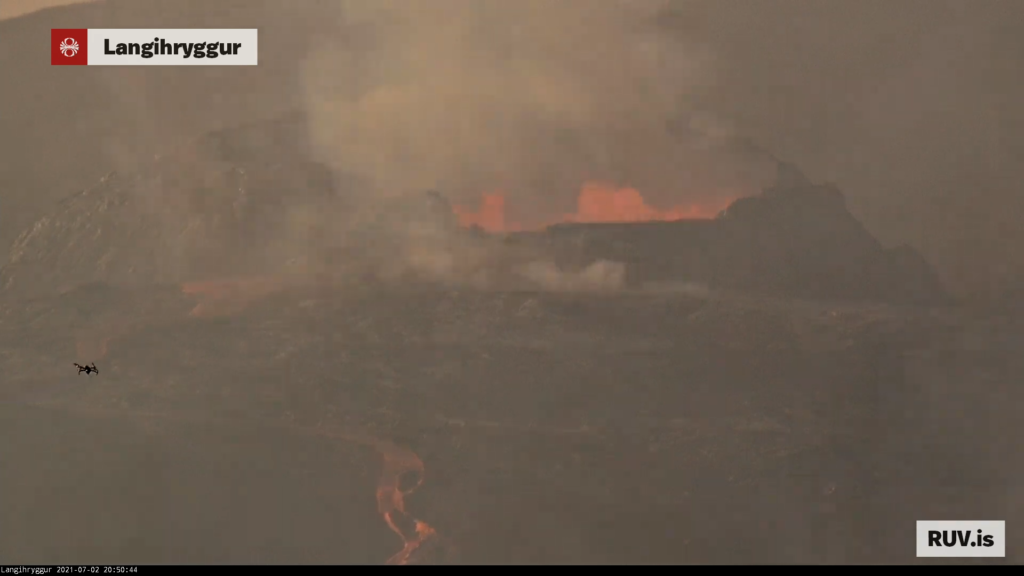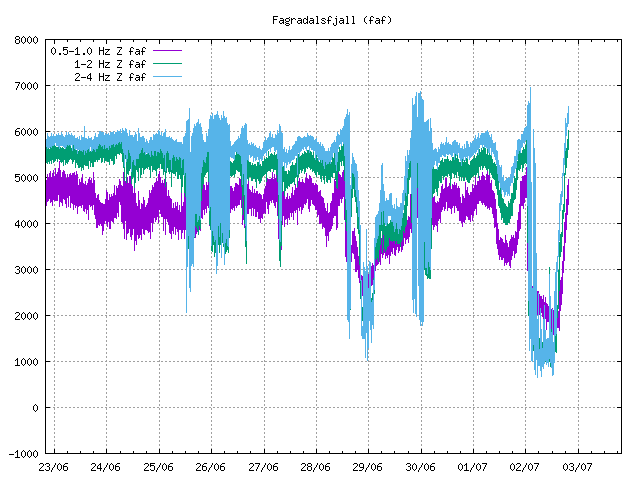In a surprise move the activity in Fagradalsfjall mountain (part of Krýsuvík-Trölladyngja volcano system) started to increase again around 16:00 UTC and around that time the first lava was seen in the crater after it had emptied it self out during the night as was mentioned in last article.
I have been following eruptions for a long time and this is the first time that I see this happen in a crater eruption. Normally when they collapse in this way the eruption is normally over. In this case the magma cleared out the rock from the collapse over few hours (it just goes down the stream with the lava) and the eruption started as the pressure did build up again in the deep magma system. Harmonic tremor has increased again since 16:00 UTC. I don’t know if it has reached its maximum yet. That is possible, but difficult to be sure.

It is impossible to know for sure what this eruption does next. Since this eruption seems to be breaking a lot of the normal rules that happens during an eruption.

Currently there is a lot of lava flowing into Nátthagi and possibly also into Geldingadalir that is already full of lava and is about to overflow at lowest points in next few days.

A night of wild excess…a black fart at 4 am… then back to normal 🙂
Magma still red hot under the crater, then pressure release gave us an ash cloud. Now continuous eruption. Starting to act like a regular stratovolcano now. It’s maturing.
There is a huge amount of lava flowing into lower Meradalir. At one point today it looked like one large lava lake. There appears to be some sort of channel out of the crater that transports lava to Meradalir through lava tubes that is not visible from the surface. RUV had a “panorama” cam on YouTube for a while yesterday and when the crater began to fill but before it began to spill over the rim, a spreading lava lake was visible forming in Meradalir. A YouTube account called Iceland Volcano Timelapses has the IMO photos. So there is obviously some lava transport channel directly from the crater into lower Meradalir.
They have constructed a new lava barrier at the outlet of Nátthagi to attempt to delay the lava exiting the valley. It looks constructed in a similar way as the previous barriers. It will not stop the lava but could delay it for a while.
The east wall of the crater appears to my eye to be thinning. Some aerial photos of the crater were posted yesterday while the eruption was stopped and it is obvious there have been significant collapses of both the east and north walls. If the east wall were to collapse and break through, I think nearly 100 percent of the lava would then divert to Meradalir and that might save the coast road for a while longer.
Not being a volcanologist, the most likely scenario in my humble opinion is the following:
This volcano is special in the sense that it does not (yet) have a magma chamber but sports a direct magma conduit down to the mantle. The gas bubbles forming in the conduit due to outgassing of the rising magma push the magma forcefully upwards and out of the conduit — thus the pulsating behaviour. In the early eruption phase the conduit was still narrow, so the quantity of the erupted lava was low, but the gas pressure high resulting in the stupendous lava fountains.
Now the conduit is widening, the gas bubbles can move much more easily through the rising magma, the pressure is thus lower and we see no more lava fountains. But a rising gas bubble now pushes quite a lot of lava out. Once the bubble is out of the conduit, the lava flows back into the now empty space in the conduit causing the level of the lava sea in the crater to go down rapidly — until the next gas bubble comes up and pushes more lava out.
This has been going on for quite a while now.
The conduit is still widening. What happened yesterday was the conduit widening deep down again — possibly starting to create a magma chamber. The uprising magma was not able to fill the new extra volume quickly enough, so the surface lava sank back down into the conduit — leading to a collapse of the crater floor. Now the uprising magma has filled the wider conduit to the point where the lava is pouring out of the crater again.
Or to make a long story short: This eruption is far from being over. It is still in its starting phase. The conduit is ever widening, possibly creating a magma chamber. An apparent decrease at the surface simply means that the underground volume of the conduit and magma chamber have been increasing again and are currently being filled up. The surface eruption will resume once the new volume is filled up.
The character of the eruption will change once a proper magma chamber has been established and the magma starts to “ripen” down there before it is being erupted.
If a chamber is forming, then the lava composite should show a change as other crust material is added during the process. I don’t know how often they are testing the lava, but if that is happening, we should see a report down the road. Very interesting thought. This event is turning into a volcanologists/geologists dream. 🙂
I noticed a volcano in Alaska also “woke up” after this one & wondered if there was any link between them (a chain of them, was mentioned) Lots of melting of the ice cap, etc, makes me wonder.
No. No connection between Iceland and the Aleutian Island chain. As a geologist, I hear this question frequently. Volcanoes “wake up” and become dormant again because of local geologic conditions. On average, there are about 25 volcanoes erupting on Earth at any given time, around the world. Two volcanoes that are close to each other, like Nyiragongo and Nyagamugira in the DRC, can become active at the same time because they are close enough to be fed by the same deep upwelling magma along the East African Rift.
I believe the July 2 empty crater event involved some reorganization of the internal plumbing of the volcano. Previous to this event, lava boiling appeared to come from a central source in the northern area of the crater. This drone footage shows a new lava source to one side during the reawakening-
https://www.youtube.com/watch?v=GkMx3j52K5o
And now boiling seems to have two sources on either side of the crater: (go to 4:50 mark)
https://www.youtube.com/watch?v=qI5P94yd1Y8
These are not my videos, apologies for any annoying editing etc.
I see what your saying. Actually, when this was a baby, there were 2 vents side by side. Probably it’s the same 2 in 1 crater now. I also have noticed bursts of lava in the outlet area. Seems lava is overwhelming a tube there, and like a sewer drain that gets overwhelmed by water, you get water/air bursts from it. And it looks like there is a hole down low on that east side of the wall there. You can see lava. All this is heading into Meradalir. Just follow the smoke(gas) trail. I’m sure there is another tube heading into Geldingadalir, as well.
If there continues to be two separate sources of lava/gas in the crater I would expect that the walls of the crater will suffer from some erosion if they are not reinforced by some spatters to the outside portion of the walls. The previous central source created a circular crater in the non- outlet area, two sources should create an elliptical shape if the walls are not eroded through before that.
I have been waiting for something like that to happen. That would create a new outlet, and change things up a bit. An east side compromise would be best for Grindavik. The outlet wall on the east maybe weaker right now. Looks like a possible weakness near the bottom is showing, as I mentioned above.
It looks like very high magma output at the moment – I wonder what the harmonic tremor has been like over the last few hours?
It looks like the same situation as the other night. A collapse of the wall, or an internal implosion. We will wait an see if it reawakens again.
Here is a video of the crater empty on July 4. The drone operator seems to be a little timid, but you can see the bottom of the crater at the 4:12 mark. It is of course going again now, I am guessing the lava is going by lava tube to North Meradalir.
https://www.youtube.com/watch?v=Of_d3_yJ6vU
With this stop and go action, how will they ever determine it has quit for good?
A drone video showing how the lava flows fit into the overall landscape can be found here (dates to 2nd July)
https://www.youtube.com/watch?v=iXiNTgreKaQ
Quiet the last couple days, and now lava is back in the crater tonight.